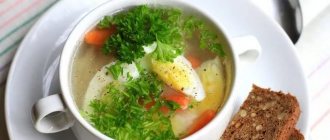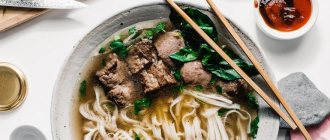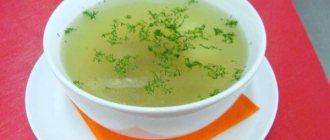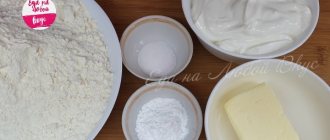Nov-29-2019 Author: KoshkaS
What are the benefits of chicken soup?
What calorie content does chicken soup with potatoes and noodles have, what beneficial properties does it have? All this is of great interest to those who lead a healthy lifestyle and monitor their health and figure. So we will try to answer these questions in the next article.
So here it is:
Poultry meat, unlike the meat of other farm animals, is rich in polyunsaturated fatty acids that are essential for humans - linoleic, linolenic and arachidonic, which account for 22% of the mass of all fats. Omega 3 and Omega 6 fatty acids have a broad and profound effect on various body systems: necessary for the normal functioning of brain cells; help remove cholesterol from the body; ensure stability of the heart and blood vessels; normalize blood pressure.
Chicken soup contains vitamins: A, group B, E, K (phylloquinone), nicotinic acid, as well as magnesium, sodium, calcium, iron, sulfur, phosphorus, selenium - a whole complex of substances necessary for the harmonious functioning of the body.
How many calories are in Chicken Noodle Soup?
Here's how much:
Soup recipe:
Components:
- Chicken fillet – 500 gr. — (550 kcal)
- Potatoes – 250 gr. — (200 kcal)
- Carrots – 100 gr. — (32 kcal)
- Onions – 60 gr. — (25 kcal)
- Vermicelli – 100 gr. — (366 kcal)
- Vegetable oil – 2 tbsp. spoons - (456 kcal)
- Water – 2 l. — (0 kcal)
- Ground black pepper – to taste – (0 kcal)
- Salt - to taste - (0 kcal)
First of all, cook the broth. For the broth we use chicken fillet, although we usually use other parts of the chicken, since they make the broth tastier and richer. But if you don’t like fatty broth, then breast is just right.
Wash the chicken fillet under running water, cut into pieces and place in a pan with cold water. Bring to a boil, then reduce the heat to low and cook for 20 minutes, skimming off the foam. At the end of cooking, add salt to taste.
Finely chop the onion and place it in a heated frying pan with vegetable oil.
Grate the carrots on a coarse grater and after 3 minutes add them to the onions in the frying pan. Fry for another 3 minutes and remove from heat. Cut the potatoes into small cubes. Remove the chicken from the broth and cut into small pieces. Add potatoes to the boiling broth and after 5 minutes add the fried chicken. Then add the vermicelli and continue to cook for as long as indicated on the vermicelli package.
Based on this recipe:
The calorie content of chicken soup with potato vermicelli, per 100 grams, is:
Recipe Chicken noodle soup. Calorie, chemical composition and nutritional value.
Nutritional value and chemical composition of “Chicken noodle soup.”
The table shows the nutritional content (calories, proteins, fats, carbohydrates, vitamins and minerals) per 100 grams of edible portion.
| Nutrient | Quantity | Norm** | % of the norm in 100 g | % of the norm in 100 kcal | 100% normal |
| Calorie content | 48.1 kcal | 1684 kcal | 2.9% | 6% | 3501 g |
| Squirrels | 2.6 g | 76 g | 3.4% | 7.1% | 2923 g |
| Fats | 1.7 g | 56 g | 3% | 6.2% | 3294 g |
| Carbohydrates | 5.5 g | 219 g | 2.5% | 5.2% | 3982 g |
| Alimentary fiber | 0.4 g | 20 g | 2% | 4.2% | 5000 g |
| Water | 61 g | 2273 g | 2.7% | 5.6% | 3726 g |
| Ash | 0.569 g | ~ | |||
| Vitamins | |||||
| Vitamin A, RE | 86 mcg | 900 mcg | 9.6% | 20% | 1047 g |
| beta carotene | 0.516 mg | 5 mg | 10.3% | 21.4% | 969 g |
| Vitamin B1, thiamine | 0.026 mg | 1.5 mg | 1.7% | 3.5% | 5769 g |
| Vitamin B2, riboflavin | 0.022 mg | 1.8 mg | 1.2% | 2.5% | 8182 g |
| Vitamin B5, pantothenic | 0.062 mg | 5 mg | 1.2% | 2.5% | 8065 g |
| Vitamin B6, pyridoxine | 0.056 mg | 2 mg | 2.8% | 5.8% | 3571 g |
| Vitamin B9, folates | 1.822 mcg | 400 mcg | 0.5% | 1% | 21954 g |
| Vitamin C, ascorbic acid | 3.62 mg | 90 mg | 4% | 8.3% | 2486 g |
| Vitamin E, alpha tocopherol, TE | 0.231 mg | 15 mg | 1.5% | 3.1% | 6494 g |
| Vitamin H, biotin | 0.055 mcg | 50 mcg | 0.1% | 0.2% | 90909 g |
| Vitamin K, phylloquinone | 0.6 mcg | 120 mcg | 0.5% | 1% | 20000 g |
| Vitamin RR, NE | 1.3085 mg | 20 mg | 6.5% | 13.5% | 1528 g |
| Niacin | 0.601 mg | ~ | |||
| Macronutrients | |||||
| Potassium, K | 115.68 mg | 2500 mg | 4.6% | 9.6% | 2161 g |
| Calcium, Ca | 7.24 mg | 1000 mg | 0.7% | 1.5% | 13812 g |
| Magnesium, Mg | 7.51 mg | 400 mg | 1.9% | 4% | 5326 g |
| Sodium, Na | 121.93 mg | 1300 mg | 9.4% | 19.5% | 1066 g |
| Sera, S | 7.19 mg | 1000 mg | 0.7% | 1.5% | 13908 g |
| Phosphorus, P | 22 mg | 800 mg | 2.8% | 5.8% | 3636 g |
| Chlorine, Cl | 194.14 mg | 2300 mg | 8.4% | 17.5% | 1185 g |
| Microelements | |||||
| Aluminium, Al | 160 mcg | ~ | |||
| Bor, B | 21.7 mcg | ~ | |||
| Vanadium, V | 24.3 mcg | ~ | |||
| Iron, Fe | 0.275 mg | 18 mg | 1.5% | 3.1% | 6545 g |
| Yod, I | 0.86 mcg | 150 mcg | 0.6% | 1.2% | 17442 g |
| Cobalt, Co | 1.531 mcg | 10 mcg | 15.3% | 31.8% | 653 g |
| Lithium, Li | 12.814 mcg | ~ | |||
| Manganese, Mn | 0.0341 mg | 2 mg | 1.7% | 3.5% | 5865 g |
| Copper, Cu | 31.23 mcg | 1000 mcg | 3.1% | 6.4% | 3202 g |
| Molybdenum, Mo | 2.462 mcg | 70 mcg | 3.5% | 7.3% | 2843 g |
| Nickel, Ni | 0.86 mcg | ~ | |||
| Rubidium, Rb | 88.6 mcg | ~ | |||
| Selenium, Se | 0.053 mcg | 55 mcg | 0.1% | 0.2% | 103774 g |
| Fluorine, F | 51.5 mcg | 4000 mcg | 1.3% | 2.7% | 7767 g |
| Chromium, Cr | 3.22 mcg | 50 mcg | 6.4% | 13.3% | 1553 g |
| Zinc, Zn | 0.1625 mg | 12 mg | 1.4% | 2.9% | 7385 g |
| Digestible carbohydrates | |||||
| Starch and dextrins | 2.456 g | ~ | |||
| Mono- and disaccharides (sugars) | 0.6 g | max 100 g | |||
| Glucose (dextrose) | 0.224 g | ~ | |||
| Sucrose | 0.344 g | ~ | |||
| Fructose | 0.077 g | ~ | |||
| Essential amino acids | 0.135 g | ~ | |||
| Arginine* | 0.133 g | ~ | |||
| Valin | 0.103 g | ~ | |||
| Histidine* | 0.088 g | ~ | |||
| Isoleucine | 0.086 g | ~ | |||
| Leucine | 0.146 g | ~ | |||
| Lysine | 0.188 g | ~ | |||
| Methionine | 0.032 g | ~ | |||
| Methionine + Cysteine | 0.064 g | ~ | |||
| Threonine | 0.086 g | ~ | |||
| Tryptophan | 0.028 g | ~ | |||
| Phenylalanine | 0.083 g | ~ | |||
| Phenylalanine+Tyrosine | 0.156 g | ~ | |||
| Nonessential amino acids | 0.226 g | ~ | |||
| Alanin | 0.099 g | ~ | |||
| Aspartic acid | 0.167 g | ~ | |||
| Hydroxyproline | 0.013 g | ~ | |||
| Glycine | 0.075 g | ~ | |||
| Glutamic acid | 0.231 g | ~ | |||
| Proline | 0.079 g | ~ | |||
| Serin | 0.085 g | ~ | |||
| Tyrosine | 0.072 g | ~ | |||
| Cysteine | 0.031 g | ~ | |||
| Sterols (sterols) | |||||
| Cholesterol | 0.74 mg | max 300 mg | |||
| beta sitosterol | 5.963 mg | ~ | |||
| Saturated fatty acids | |||||
| Saturated fatty acids | 0.2 g | max 18.7 g | |||
| 14:0 Miristinovaya | 0.003 g | ~ | |||
| 16:0 Palmitinaya | 0.195 g | ~ | |||
| 17:0 Margarine | 0.001 g | ~ | |||
| 18:0 Stearic | 0.041 g | ~ | |||
| 20:0 Arakhinovaya | 0.001 g | ~ | |||
| Monounsaturated fatty acids | 0.397 g | min 16.8 g | 2.4% | 5% | |
| 14:1 Myristoleic | 0.001 g | ~ | |||
| 16:1 Palmitoleic | 0.022 g | ~ | |||
| 17:1 Heptadecene | 0.001 g | ~ | |||
| 18:1 Oleic (omega-9) | 0.374 g | ~ | |||
| Polyunsaturated fatty acids | 0.661 g | from 11.2 to 20.6 g | 5.9% | 12.3% | |
| 18:2 Linolevaya | 0.649 g | ~ | |||
| 18:3 Linolenic | 0.022 g | ~ | |||
| 20:4 Arachidonic | 0.004 g | ~ | |||
| Omega-6 fatty acids | 0.1 g | from 4.7 to 16.8 g | 2.1% | 4.4% |
The energy value of Chicken noodle soup is 48.1 kcal.
Primary Source: Created in the application by the user. Read more.
** This table shows the average levels of vitamins and minerals for an adult. If you want to know the norms taking into account your gender, age and other factors, then use the “My Healthy Diet” application.
Calories in chicken soup
Chicken soup is one of the easiest first courses to prepare; it has a rich nutritional value, but rather low energy value. That is why it is so actively used in the nutrition of sick people, children, the elderly and those who watch their weight. There are many variations in the preparation of the dish, so in order to find out the calorie content of chicken soup with potatoes, noodles or just vegetable soup, you need to take into account its composition.
Chicken noodle soup, calories
What are the benefits of chicken soup?
What calorie content does chicken noodle soup have, what beneficial properties does it have? All this is of great interest to those who lead a healthy lifestyle and take care of their health and figure. So we will try to answer these questions in the next article.
The great advantage of chicken meat is its biological value, explained by the completeness of its proteins: 92% of chicken protein consists of amino acids necessary for humans, found in the optimal quantity and ratio.
Chicken is a recognized leader among other types of meat in terms of protein digestibility, which is determined by its low content of connective tissue fibers containing collagen. Therefore, chicken soup is recommended for people with gastrointestinal diseases. However, it has been proven that with a large amount of adipose tissue in any meat, the relative content of proteins decreases, and their digestibility also decreases. That is why the meat of laying hens is the most optimal nutrition option for such diseases.
Chicken broth with egg: calorie content and benefits during a diet
Nowadays, various low-carbohydrate protein diets are very common. High protein foods become the basis of the diet during this period, and chicken breast and chicken eggs occupy a leading place in this.
It’s true that you can’t afford much hot food at this time – only chicken broth with eggs. And it is prepared simply: formally, it is a broth into which, immediately before serving, a previously boiled and cut in half chicken egg was inserted.
You can calculate the nutritional value of this product as follows:
- separately, the nutritional value of the broth is from 18 to 100 calories per 100 grams;
- The nutritional value of a chicken egg is 78 calories in 1 egg (weight about 50 grams).
- All you have to do is add up the available calories and get the result.
It should be remembered that nutritionists consider this soup to be especially useful; it contains peptides, amino acids and fatty acids that are essential in the human diet and extremely important for healthy life.
What else does the calorie content of broth depend on?
It’s clear that you can cook chicken breast broth in different ways, for example:
- skinless chicken breast broth;
- chicken breast broth with skin;
- broth with noodles or vegetables;
- pure broth, no meat.
That’s why the difference in calorie calculations is quite large. If you take pure broth cooked from chicken breast , from which the skin was previously removed and cooked at a one-to-one ratio of water and meat, then the nutritional value of this product will be minimal - only 18 calories per 100 grams of product.
But if it is a thick, rich broth, cooked from a large amount of chicken breast with skin, if potatoes, carrots and noodles were added there, then the nutritional value of such food increases significantly. In this case, it may exceed 100 calories per 100 grams of product.
Rules for preparing low-calorie soup
- Rule one - buy only breast!
- Rule two - be sure to remove the foam that forms during boiling, since it contains the maximum amount of unnecessary fat. Some extreme sports enthusiasts even advise leaving the broth in the refrigerator for several hours. All the fat is collected at the top and mercilessly drained.
- Rule three - under no circumstances prepare chicken soup with noodles: the calorie content of the latter is in no way suitable for dietary nutrition.
- Rule four - the broth should be cooked slowly and leisurely, for almost an hour. About 30 minutes before “time X” you need to add onions and carrots, peeled, but not cut or fried, for flavor and to awaken the appetite. This leads to the fifth (and final) rule: do not fry any vegetables before adding them to the broth. They are saturated with oil and become very satisfying. And even more so, you should avoid frying if you are preparing chicken soup with noodles - the calorie content of such a dish is already high, so you should not aggravate the situation.
What are the calories in chicken broth?
Of course, it is always tastier to treat yourself not only to the broth in which the meat was cooked, but also to the meat itself, so often such a dish as broth is not only a liquid component, but also meat finely chopped into a hot broth.
The nutritional value of chicken broth with chicken meat is about 100 kcal per 100 grams of product.
Traditionally, meat makes up about half the serving, the other part is a rich liquid, salted and seasoned to taste.
It’s easy to calculate calorie content here; there’s even a special formula for this. You need to multiply by a factor of 0.9 the amount of meat that was used for the broth (provided that it was cooked in a one-to-one ratio).
Thus, knowing that the calorie content of chicken breast is about 110 calories per 100 grams, the calorie content of chicken broth will be about 100 calories.
Ways to overcome the calorie content of broth
How to “defeat” the overall nutritional value of soup? Obviously: just don’t put high-calorie ingredients in it. But there is still the richness of the broth, which is also possible to overcome. First of all, all fat is removed from any piece. Equally important is removing the skin - it increases the calorie content of chicken soup. So the ideal purchase choice would be chicken fillet. Removing the skin immediately reduces the calorie content by three times.
The right move would be to drain the first broth: the meat has been cooked for a quarter of an hour and the broth goes into the toilet. It’s a pity, of course, but the next one will be more dietary.
If the broth has been in the refrigerator overnight, do not forget to remove everything from it, even the smallest bits of fat. Now your soup will be truly low-calorie!








